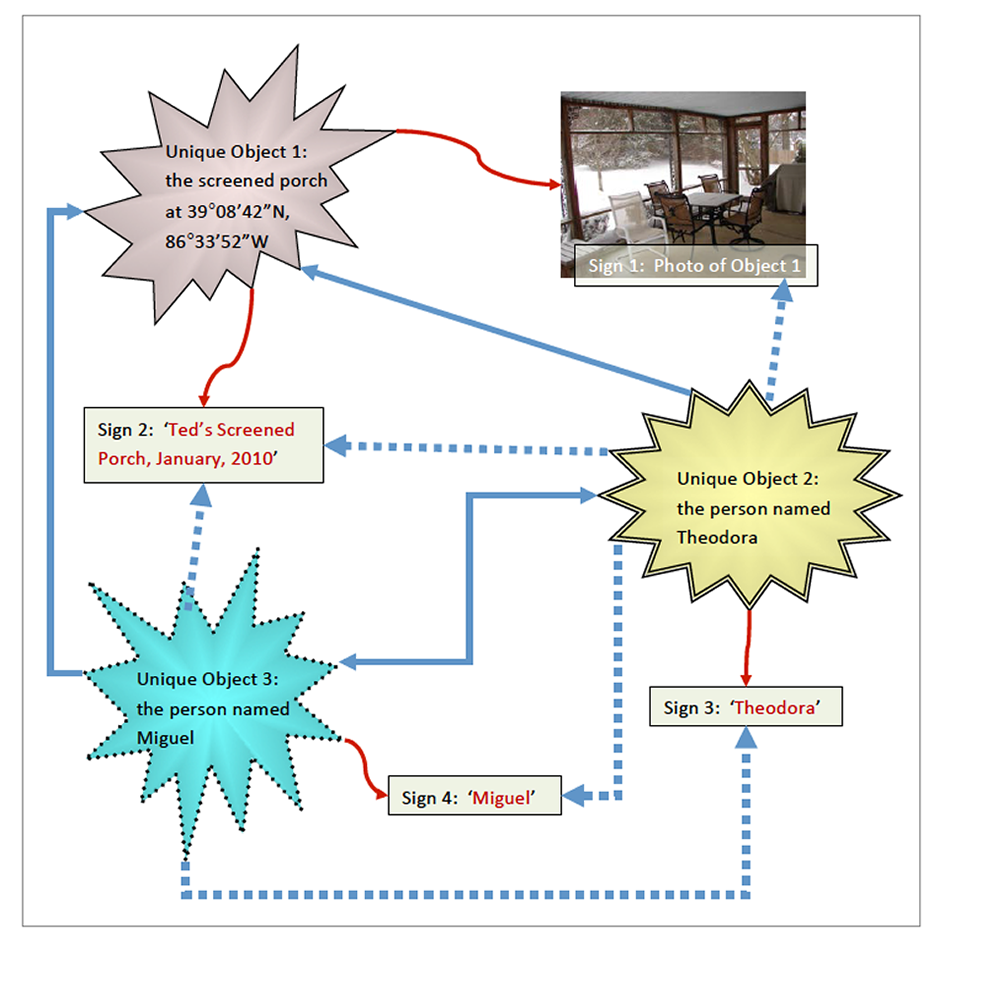Indexical Sign-Object Relation
According to C. S. Peirce (1932):
An Index is a sign which refers to the Object that it denotes by virtue of being really affected by that Object…. In so far as the Index is affected by the Object, it necessarily has some Quality in common with the Object, and it is in respect to these that it refers to the Object (2:248, bolding added)…. A genuine Index and its Object must be existent individuals (whether things or facts), and its immediate Interpretant must be of the same character. But since every individual must have characters, it follows that a genuine Index may contain … an Icon as a constituent part of it (2:283, bolding added).
To be clear about this, consider the illustration in the image below. There are three unique objects—two of which are persons and the screened porch—and four signs.

There are relations between these objects and signs. Sign 1 is an index, since the photograph (the sign) is clearly “affected by the object” and it has “some quality in common with the Object” (the screened-porch-that-Ted-Frick-built-in-1993). An index need not be restricted to an image. Sign 2 also functions as an index, consisting of words describing the object (‘Ted’s screened porch, January 2010.’). Likewise, Signs 3 and 4 are used to index unique, existent individuals (‘Miguel’ and ‘Theodora’ respectively)*.
Furthermore, Theodora recognizes Miguel, and Miguel recognizes Theodora, represented in the image above by a solid blue line with arrowheads on each end. Theodora recognizes the screened porch, and so does Miguel. As interpretants, Miguel knows that Sign 4 is connected with the unique person, Theodora; and Theodora knows that Sign 3 is connected with the unique person, Miguel; and Theodora knows that Sign 1 represents the unique Object 1, the screened-porch-built-by-Ted-in-1993.
However, the screened porch does not recognize either Miguel or Theodora, since the screened porch is not a person with a mind and is not self-aware or conscious as are Miguel and Theodora. Both Theodora and Miguel have had direct experiences with the unique object 1, which is the basis of their recognition. Their recognition is grounded. Their relationship with the screened porch has been immediate in their experience at some time previously. The screened porch depicted in the image above and its signs are shared between subjects (the persons Theodora and Miguel) and hence are intersubjective.
On the other hand, you, the reader, most likely have never physically visited nor directly experienced the unique screened porch that Ted built in 1993. Unless you have been there and have directly experienced it, you do not directly ‘know that one’-screened-porch, although you may now know signs associated with that unique object. Your experience with this screened porch is mediated by signs. Your experience is not immediate. Your experience of that-one-screened-porch-built-by-Ted is not authentic. It is not grounded. You may ‘know that’-specific-fact—with respect to remembering the signs that have been associated with their objects by some other interpretant.
See also:
*Obviously, the actual persons, Theodora and Miguel, and the actual screened porch are not in the image above, but are represented by unique star-shaped signs to the reader (but let’s leave you, the reader, as another interpretant, out of the picture for now).
